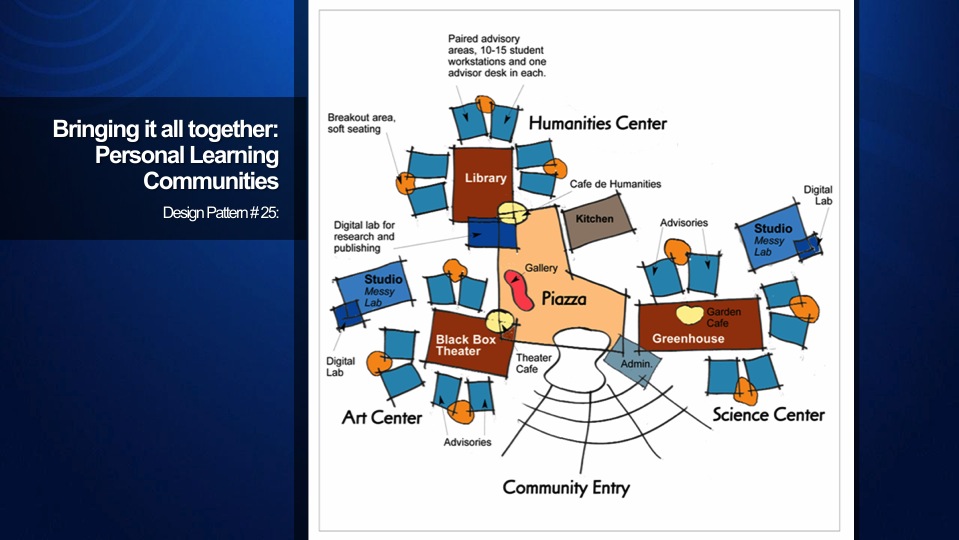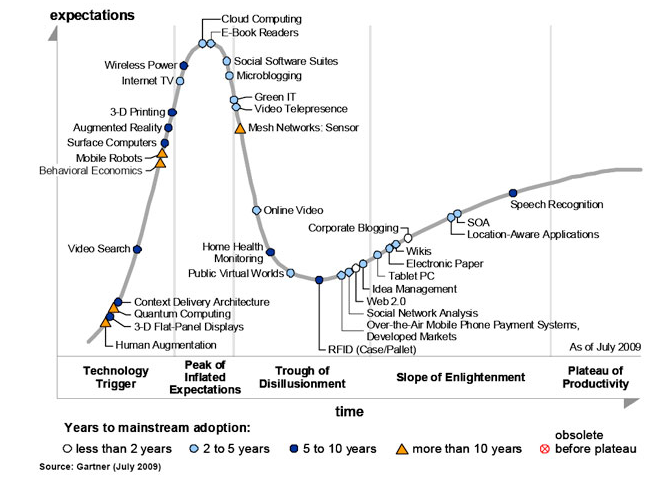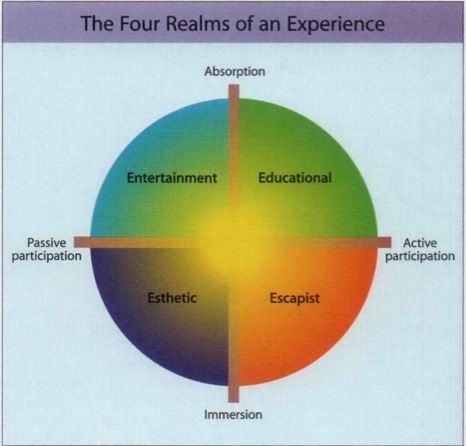So this week, I took a look at some museums and exhibits in Second Life, with a particular focus of analyzing them based on some of the research and writings on museum exhibits and design. Although we’ve used authors like Falk and Dierking, Pine and Gilmore, to name two, I decided to utilize a few new resources to help me frame my thinking about my visits (Urban, Black, Gammon). Full bibliography is at the bottom, with some key ideas from those articles underneath.
As a general point of discussion, none of the sites I visited covered all of the appropriate design ideas. What there was, however, with some insight in each one about strengths and needs for improvement to make the experience more vivid and powerful.
In order:
Exploratorium:
http://slurl.com/secondlife/Exploratorium/192/202/25
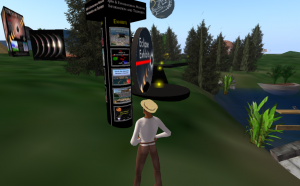 When you arrive at the Exploratorium Island, There are a variety of interactive exhibits to explore – test your ability to track objects, be a molecule undergoing brownian motion, or take some visual perception tests. From a Gammon’s work, there is a definite sense of each exhibit attracting and holding attention. Urban emphasizes the importance of setting, media richness, and user agent. These are all true for the many exhibits that populate this space. Black details 23 characteristics for visitor involvement, and these exhibits do engage including features like enjoying the activity, it is enjoyable and planned out, users have the power to select, learning will occur because of participation. Each exhibit by itself clearly shows effort in the design.
When you arrive at the Exploratorium Island, There are a variety of interactive exhibits to explore – test your ability to track objects, be a molecule undergoing brownian motion, or take some visual perception tests. From a Gammon’s work, there is a definite sense of each exhibit attracting and holding attention. Urban emphasizes the importance of setting, media richness, and user agent. These are all true for the many exhibits that populate this space. Black details 23 characteristics for visitor involvement, and these exhibits do engage including features like enjoying the activity, it is enjoyable and planned out, users have the power to select, learning will occur because of participation. Each exhibit by itself clearly shows effort in the design.
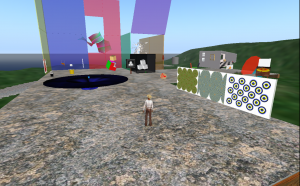 Some shortcomings here included a lack of cohesiveness that Urban might attribute to lack of consideration of setting. Gammon states the importance (as do many others) of linking to prior knowledge. Black uses the phrase “clarity of vision”. Although the exhibit is bright, full of interesting exhibits, and covers a range of science topics, there is a lack of a general sense of the plan, and signage is minimal to the point of being confusing. Probably most frustrating for me, was the lack of depth of the science explained. With the opportunity for lots of different media richness (Urban), I felt the designers could spend more time providing better information, learner guidance, and differentiated entry points for learners (Black).
Some shortcomings here included a lack of cohesiveness that Urban might attribute to lack of consideration of setting. Gammon states the importance (as do many others) of linking to prior knowledge. Black uses the phrase “clarity of vision”. Although the exhibit is bright, full of interesting exhibits, and covers a range of science topics, there is a lack of a general sense of the plan, and signage is minimal to the point of being confusing. Probably most frustrating for me, was the lack of depth of the science explained. With the opportunity for lots of different media richness (Urban), I felt the designers could spend more time providing better information, learner guidance, and differentiated entry points for learners (Black).
To compare the site to others, I also visited:
Basilica San Francesco Assisi:
http://slurl.com/secondlife/san%20francesco%20assisi/246/109/68/?i&title=San%20Fran cesco%20Assisi
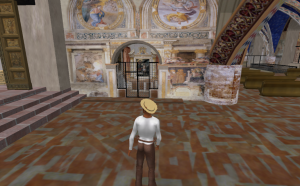 This site has a striking look and feel to it. Unlike the Exploratorium above, the site was rooted in reality. This location addresses the scale and setting issues brought up by Urban in his article. Although I’ve not been to this location in real life, it has the authentic look and feel of the original space in Italy. One of the impressive features was the opportunity to purchase a heads-up display, that gave guidance and information for many way stations along the path. For the most part I found this display helpful, but there were some glitches. The controls did not always work, and once a description started, it kept looping until you are out of the approximate range of that specific exhibit. is probably the most frustrating aspect of this design (for me anyway) was a general lack of direction available to guide a visitor through. Although the heads-up display gave useful information, it was not as intuitively easy to use as it might’ve been, and more importantly, did not really the two specific places within the building.
This site has a striking look and feel to it. Unlike the Exploratorium above, the site was rooted in reality. This location addresses the scale and setting issues brought up by Urban in his article. Although I’ve not been to this location in real life, it has the authentic look and feel of the original space in Italy. One of the impressive features was the opportunity to purchase a heads-up display, that gave guidance and information for many way stations along the path. For the most part I found this display helpful, but there were some glitches. The controls did not always work, and once a description started, it kept looping until you are out of the approximate range of that specific exhibit. is probably the most frustrating aspect of this design (for me anyway) was a general lack of direction available to guide a visitor through. Although the heads-up display gave useful information, it was not as intuitively easy to use as it might’ve been, and more importantly, did not really the two specific places within the building.
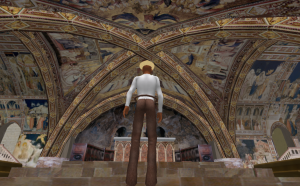 It was interesting to me that both visits (and the others I looked at) all lacked some major elements that would’ve made the visits more engaging. It certainly cuts to the core of Urban’s comment about developers who are using Second Life as a “Third Space”. Although they are passionate in creating very interesting spaces, they are not fully applying all the principles of good design into the spaces consistently, and thus minimizing the impact that these places might have if they were more fully thought through.
It was interesting to me that both visits (and the others I looked at) all lacked some major elements that would’ve made the visits more engaging. It certainly cuts to the core of Urban’s comment about developers who are using Second Life as a “Third Space”. Although they are passionate in creating very interesting spaces, they are not fully applying all the principles of good design into the spaces consistently, and thus minimizing the impact that these places might have if they were more fully thought through.
Readings that have specific information that is applicable to virtual world design:
Black, G. (2005). The engaging museum : developing museums for visitor involvement. London ; New York: Routledge.
Gammon, B. (2003). Assessing Learning in the Museum Environment [Electronic Version], from http://sciencecentres.org.uk/events/reports/indicators_learning_1103_gammon.pdf
Urban, R. et al., A Second Life for Your Museum: 3D Multi-User Virtual Environments and Museums, in J. Trant and D. Bearman (eds.). Museums and the Web 2007: Proceedings, Toronto: Archives & Museum Informatics, published March 1, 2007 Consulted October 4, 2009. . http://www.archimuse.com/mw2007/papers/urban/urban.html
NOTES:
Urban:
Key ideas: developers in Second Life are often using it as a “third place” to develop their serious leisure pursuit.
Characteristics of Second Life environments:
scale: there’s a lot of flexibility in Second Life to work in the scale of your project based on your intention, and not in the physical limitation.
Setting: how artifacts are displayed is very open to interpretation. Some spaces minimize the setting to make the artifacts standout, others create a rich copy of the original space to set their setting, others invent new ways of representing the works.
persistence and evolution: more so than real-world, Second Life spaces evolve dramatically over time, which can be both powerful and unsettling for return visitors.
Media richness: a Second Life exhibits can incorporate powerful use of media to enhance the experience. Whether it is sound, video, or just interactivity, all of these features create the opportunity for a rich experience.
visitor engagement: There are many opportunities in Second Life to create this gauge, and invite people for second and third visits based on their experience.
Intended purpose: although it is not possible in Second Life to re-create any specific real-life equivalent, there is a need to match the intent of the space, and the design as close as possible
Collection types:it is possible to have a variety of types of artifacts and Second Life — from replicas of original objects like paintings, to interactive models in which participants can take an active role. The spectrum across these wide variety of the exhibit types within the Second Life environment create multiple opportunities for experienced.
Target audiences: because of the anonymous nature of Second Life, collecting specific information about the audiences for exhibit is challenging, if not entirely impossible. That makes targeting exhibits based on user experience a tricky problem indeed.
Gammon:
Specific ideas he mentions about learning in museums:
Cognitive
Affective
Social
Developing skills
[mental and physical]
Personal
Specifically:
Does the exhibit:
Attract and hold attention — absorbed, repeat, attend for requisite time
comprehend content — challenging but achievable, attain detail and depth, makes difficult easy to understand
increase or consolidate knowledge — clarify, consolidate, address open-ended, retention weeks later, pre-post increases
link to prior knowledge — connectedness through mapping, Everyday experience,
process and apply information — new ideas, deep discussion capability, use information to complete task
challenge belief, attitudes, values — change is evident, new perspective
inspire strong emotional reactions — emotive language, described exhibit in personal emotional terms
increase awareness of other people’s beliefs, attitudes and values — spontaneous empathy, tolerance
increase empathy with other people’s beliefs and attitudes and values –
develops skills of cooperation
develop skills of communication
increased sense of self-confidence and self efficacy
increased sense of identity and self-worth
inspire interest and curiosity
motivate to investigate further
associate experience with positive feelings
skill-based — prediction, deduction, experimentation, decision-making…
numeracy and literacy skills
manual dexterity and other skills
artistic appreciation and criticism
Black:
a model for interpretive planning
when you wish to present such a specific site resource issues themes etc.
who you’re targeting the presentation I have to consider the nature of the target audiences there needs to expect patience
why you wish to develop/change the presentation — by defining specific objectives and outcomes. What are the benefits for the visitor, for the site collections, for the organizations, and our these benefits evaluated
how do you intend to present the museum — the interpretive strategy and gallery concepts — to achieve the objectives of the outcomes required
key principles:
interpretation is inclusive
external image is vital
interpretation emphasizes the overall visitor experience
the threshold is all-important
atmosphere matters
through orientation, interpretation gives visitors the power to select
interpretation is enjoyable
interpretation should be based on the latest audience research
interpretation seeks to use visitors personal context to build on pre-existing experience, skills and knowledge
interpretation is planned
interpretation emphasizes clarity of vision
the interpretation itself must be selective and themed
sound interpretation requires sound research
sound interpretation recognizes multiple points of view
interpretation is committed to active viewer participation
Interpreters believe learning occurs as a result of visitor participation
visitor participation means “pacing” displays
visitor participation also needs rest, recuperation and time for reflection
visitor participation means encouraging social interaction
visitor participation requires an impact on the emotions and senses as well as on the intellect
visitor participation requires a palette of approaches and layering of content
interpretation must also relate to the detail
interpretive approach will enable regular change into continuous program of activities and events





